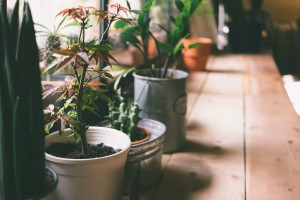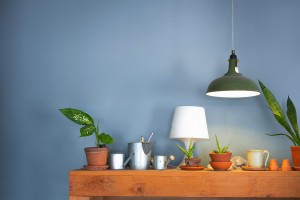
Are you really missing your time in the garden? Instead of puttering outside, this is the chance to focus on plans for next season and to shift your attention to indoor plants. Indoor plants play a vital role in air quality in our homes, add beauty to our living space, and keep us connected with nature.
This time of year is bittersweet for me. It is similar to having the grandkids for a weekend – saying goodbye to them until next time with a sense of relief, but also an anticipation of our next time together. It is a time of rest for garden and gardener alike!
Indoor plants
The benefits of having plants in our home are numerous: they purify and filter the air; they can soften the hard edges of any room; some have culinary or medicinal properties; they convert carbon dioxide to oxygen and filter and remove some of the toxins from the air.
There are a few basic guidelines to follow when growing and maintaining indoor plants. Do your research if a plant is not doing well in your home or before buying new plants. There are many excellent books, online information and knowledgeable nursery staff willing to share their expertise. Here are a few areas to pay particular at- tention to:
Lighting is the first thing to consider when selecting a location for a plant. Only a small group of plants can tolerate direct sunlight for extended periods of time and they are cacti and succulents. Some plants need lots of light, but not direct sunlight. Others tolerate both sunlight
and indirect light. The level or quantity of light is a consideration.The brighter the light, the more energy the plant receives.
Temperature is very important to a plant’s success. Most plants are adaptable and will be alright in temperatures above or below the recommended range for short periods of time. Be aware of drafts, or placing plants too close to a window during excessive cold periods. Most plants will thrive in temperatures between 13 to 24 C.
Humidity is often the most difficult to control in- doors. Most plants prefer and require higher levels of humidity than provided during the winter months from central heating. There are several inexpensive ways to in- crease humidity. These include misting, grouping, pebble trays, double potting and humidifiers. Mist with room temperature or tepid water, avoid misting in direct sunlight, try and mist both sides of the leaves and avoid the buds or flowers. Misting is also a really good way to keep an eye on your plants for insects or damage. Grouping plants in- creases humidity levels through a process called transpiration, which creates a humid microclimate. Using pebble trays is a good way to beautify your plant presentation and provide moisture. Double potting may work for you as well. Insert plant pot into a more decorative, waterproof pot containing moist peat moss. Keep peat moss continually moist.
How much and how frequently you water determines your plant’s survival. With practise, one can determine when plants need to be watered by their appearance and weight, or by the simplest method of all – your finger!
A few factors come into play when watering indoors, including size and type of pot, time of year, potting soil, type and size of plant, level of humidity and light. There are two methods of watering: on the soil’s surface, or from below, using the immersion method. Some plants need to be watered every couple of days, while others weekly and others only monthly. Do your research on each plant before you water. One of the most common reasons we lose plants is over-watering. Over-watering can result in rot of the root ball, and once this has set in, there is little chance the plant will survive. Water carefully and according to the plant’s needs.
Shapes to choose from include bushy, upright, climbing and trailing. Always verify how large plants will become at maturity. Once you have a shape in mind, consideration should then be given to whether you prefer a flowering plant or one with only foliage.
Group plants to have the same requirements for light, water and humidity. Place taller ones at the back and smaller ones at the front and sides. Leave suitable space between pots for easy access and adequate air circulation.
In addition to the above, we need to be mindful of the following items necessary for healthy plants: potting mixes, types of containers, repotting, pruning, training and support techniques, cleaning and fertilizers.
Air-filtering plants
NASA did a study a few years ago to find out which plants were best to filter the air of the space station. These plants not only produce oxygen from CO2, but they also absorb benzene, formaldehyde and trichloroethylene.
Here are a few plants that contribute to air-filtration and the chemicals they absorb:
Garden mum, according to NASA research, was an air- purifying champion, removing benzene, ammonia, formaldehyde and xylene from indoor air.
Spider plants are very easy to grow and a great choice for beginners. They like bright, indirect sunlight. They will send out shoots with flowers that will grow into baby spider plants. They remove formaldehyde and xylene.
With more than 40 different kinds of dracaena plants, most of us should be able to find one we like! They also re- move benzene, formaldehyde, trichloroethylene and xylene.
Ficus or weeping fig is a tree and usually grows be- tween two and 10 feet (one and three metres) tall. Keep this in mind if you wish to add this tree to your home. It is a low-maintenance plant and grows best in bright, indirect light. This plant also does well when taken outside in late spring and returning it to a warm house well before frost. Removes benzene, formaldehyde and trichloroethylene.
Peace lily plants are small compared to many of the plants on NASA’s list, but do have great air-cleaning abilities. They remove ammonia, benzene, formaldehyde and trichloroethylene.
Boston ferns prefer a cool location with high humidity and indirect light. They are relatively easy to grow and also remove formaldehyde and xylene from your home.
Snake plant/mother-in-law’s tongue is a tough plant and is ideal for the beginner and those with less than a green thumb. It prefers drier conditions with some sun.
Like dracaena, it removes the same toxic chemicals from our home.Bamboo palm is great at filtering formaldehyde. Plants thrive in full sun or bright light. One reason it can filter so much toxic air is because of its size, as it can grow from four to 12 feet (one to four metres) high. They also remove benzene and trichloroethylene.Aloe vera holds serious health claims. Not only does the plant’s leaves contain clear liquid full of vitamins, enzymes, amino acids, and other compounds that have wound-healing, antibacterial and anti-inflammatory properties, but it may also help skin conditions like psoriasis. They are easy to grow and help re- move formaldehyde. Sounds like a plant all homes should have!
Although somewhat limited, indoor plants can be affected by some insects, pests and diseases, but once identified, are quite easy to eradicate.
Aphids are often found on the newest, most tender growth and can come in a variety of colours such as green, brown, black, yellow, red or grey. Rinse off the aphids; squish them with your fingers; or spray with insecticidal soap.
Botrytis is a grey, fuzzy mold and is easily seen on the foliage. It can affect all parts of a plant if conditions are humid and cool with poor air circulation. Remove all infected areas, or, if too far gone, dispose of the entire plant. Cut back on watering, improve ventilation and avoid wetting the foliage.
Fungus gnats are tiny black flying insects often confused with fruit flies. Gnat grub-like larvae often feed on young roots. Adults are attracted to fungus growing in moist or web compost, or potting mix. To control gnats, allow the surface of potting mix to dry slightly between waterings. Once the surface dries, the food source disappears.
Powdery mildew is a fungal disease that appears as a white powdery coating. It occurs most often in locations with poor air circulation and high humidity. To control it, improve air circulation and remove infected portions of the plant.
Treat foliage with a mix of baking soda and water or a non-toxic fungicide for indoor-use only.
Check plants regularly for pests, and once discovered, treat immediately. When bringing new plants into your home, check them for any forms of insects or disease.
To the gardener, indoor plants are a necessity and deserve as much care and attention as do our outdoor plants! Enjoy the pleasures of all types of gardening!

Gift-giving
When buying gifts for gardeners, keep in mind there are numerous items to choose from. I feel gardeners are the easiest people to shop for. There are wonderful books, handy tools and gadgets, clothing, seeds, magazine subscriptions and plants that will be well received.
If you have grandkids who are interested in plants, nature and the environment, now is an excellent time to embrace this interest and pass on our gardening knowledge and techniques to this eager generation. Gardening teaches children about plant cycles, responsibility, patience and the joy of taking ownership of a project. There are numerous websites with excellent information on getting your grandkids started on a path of gardening, including www.youreasygarden.com. In addition, there are craft ideas for youngsters online, including such websites as pinterest.com and www.craftionary.net. There are also wonderful children’s books available. Spend time with your grandchildren while gardening; encourage them to help plant, weed and harvest items. Your gardening talents should be shared and passed down to the next generation. Happy gardening! n
Irene Morton, owner of Earth Spirit Garden Care, is an avid gardener, spiritualist and traveller who lives in Kingston.






